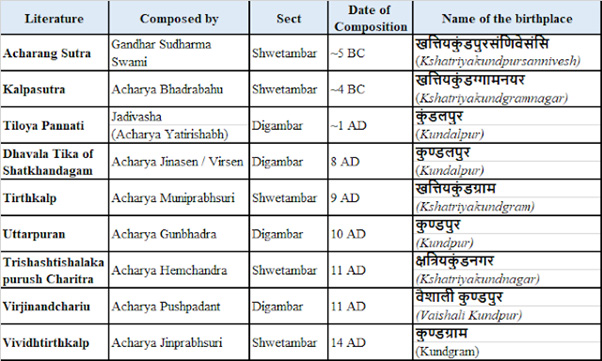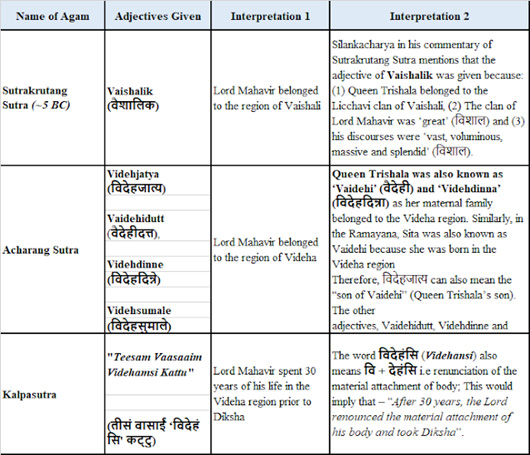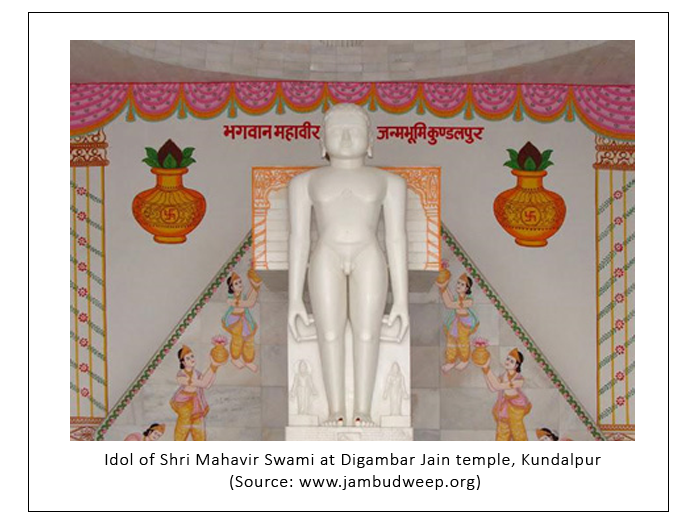Continued from last month’s issue……
Jainavenue is a medium to serve the spiritual path of Jainism

A. Literary Evidence:
To begin with, let us examine the details available in ancient texts (chronologically), which throw some light on the distinctive names of Lord Mahavir’s Birthplace (similar names in different texts not repeated)-

Based on the above, we find eight distinctive names of the birthplace of Lord Mahavir as below-
1. Kshatriyakundpur-sannivesh
2. Kshatriyakund-gram-nagar
3. Kundalpur
4. Kshatriyakund-gram
5. Kundpur
6. Kshatriyakundnagar
7. Vaishali-Kundpur
8. Kundgram
Apart from the word ‘Kund’ which is common in all the names, each name has a distinctive character, making it different from others. [Note: The three locations believed to be the birthplace also have the word ‘Kund‘ in their names (Kundghat, Kundalpur and Basukund).
The earliest reference of the name of Lord’s birthplace occurs in Acharang Sutra, which mentions the name of the birthplace as – Kshatriyakundpur-sannivesh. The Tika (commentary) of Acharang Sutra gives us the details of the word ‘Sannivesh’, which means a halting place for caravans, processions, and travelers. Thus, it gives the impression that the town was not a very significant place. Kalpasutra, which was composed around 150 years after the Acharang Sutra gives the name of the birthplace as “Kshatriyakund-gram-nagar”. The word ‘gram‘ means a village whereas the word ‘nagar‘ means a city; thus, the conjunction of both the words “gram-nagar” would mean that Kshatriyakund was not a large city but a small town or a suburb. Further, Trishala was titled as ‘Kshatriyani‘ (क्षत्रियाणी) in the Agams (not as a queen). Based on this information, some scholars have assumed that Siddharth was an ordinary Kshatriya and not a king. However, there are evidence in the Kalpasutra and Bhagvati Sutra which disagree on the said assumption (as below)-
- Siddharth was titled ‘Raja‘ and ‘Narendra‘; he was embellished with Mukut (crown), Alankar (jewelry) and Chhatra(silver umbrella);he employed more than 20 categories of servants and had a large army at his disposal;
- When Lord Mahavir was born, King Siddharth released all the prisoners of his state;
- Lord Mahavir gave away valuables worth 388 crores of gold coins in Varshidan;
- Jamali, Lord Mahavir’s son-in-law, took diksha with 500 other residents of Kshatriyakund (which shows that Kshatriyakund was a large city).
Based on the above details, we can assume that Kshatriyakund was not a suburb but a city and Siddharth was not an ordinary Kshatriya but a King. The later names of the birthplace also have the suffix of ‘Pur‘ and ‘Nagar’ which in Devanagari, means a city. Based on the above facts, let us now delve deeper into the literary evidences noted in favor of each place considered as the birthplaces of Lord Mahavir.
- a. Literary / anthropological evidence in favour of VASOKUND/ BASUKUND in Vaishali District –
i. Most of the later Jain texts (Nirvanbhakti, Harivanshpuran, Uttarpuran, Virjinandchariu, Vardhamancharitra etc.) specifically locate the birthplace of Lord Mahavir in the Videha region. Adjectives to Lord Mahavir, with reference to the same were also given in the ancient Agams (as discussed below, along with different interpretations). The territory of Videha region is located north of the Ganga River, in the northeastern part of Bihar and eastern Terai of Nepal. Vaishali falls in this region, whereas Kundghat (near Lachhuar) was a part of Anga region and Kundalpur (near Nalanda) was a part of Magadha region.

ii. The Buddhist text, Mahavagga (~5 BC) mentions that Kundpur was a suburb of Vaishali.
iii. The Buddhist text, Therigatha Atthakatha (~1 BC), mentions that Lord Vardhaman belonged to the Licchavi Royal Family of Vaishali (वेसालियं लिच्छवि राजकुले निब्बत्ति वड्ढमानो तिस्स नामं अहोसि).
iv. Various scriptures mention the name of a river named ‘Gandaki’ near the birthplace of Lord Mahavir. This river is situated near Basukund, Vaishali.
v. A tribe in the Basukund (Vaishali) named ‘Jatharia’ claims to be the original descendants of Lord Mahavir. Since ages, the Jatharia’s had preserved a large part of land, which they believed to be the birthplace of Lord Mahavir. Post-Independence, the plot was handed over to the Government of India, which was used to construct the Janmasthan temple in Basukund.

1. b. Literary evidence NOT in favour of VASOKUND/ BASUKUND in Vaishali District-
i. All historical and Buddhist sources state that Vaishali was a republic (a state in which supreme power is held by the people and their elected representatives, and which has an elected or nominated governor) and not a monarchy. On the other hand, all the Jain sources indicate that Kundpur was an independent kingdom and not a part of any republic. Therefore, the birthplace of Lord Mahavir, i.e., Kundpur was not a suburb or a part of Vaishali (There could be another place called Kundpur in Vaishali as identified by the Buddhists).
ii. As per Acharang Sutra and Kalpasutra, out of the 42 rainy seasons (Chaturmas), spent by Lord Mahavir during his lifetime, 7 were at Vaishali. However, none of the texts record that Lord Mahavir spent any of the 42 Chaturmas’ at his birthplace.
iii. As per Jain, Buddhist and other historical sources, King Ajatshatru of the Magadha dynasty fought a war in 468 BC to conquer Vaishali, which was governed by Chetak (Lord Mahavir’s maternal uncle). All the sources unanimously agree that Ajatshatru defeated Chetak, which implies that Vaishali was governed by Lord Mahavir’s (maternal uncle and not his father).
The Jain texts also state that Lord Mahavir was born in King Siddharth’s palace and not at his maternal uncle’s residence. Jain texts also state that after the fall of Vaishali (post attack by Ajatshatru), Nandivardhan continued to rule over Kundpur (as per Trishashtishalakapurush Charitra,) King Nandivardhan went to meet Lord Mahavir when he arrived in his birthplace post Kevalgyan.
iv. Lord Mahavir spoke in the Ardhamagadhi dialect, whereas the local dialect in Vaishali and Videha region was Vajji. The regions under Kundghat and Kundalpur fall in the Magadhi speaking zone.
2. a. Literary / anthropological evidence in favour of KUNDALPUR in Badgaon,Nalanda District-
i. As per Tiloya Pannati, Lord Mahavir was born to King Siddharth and Queen Priyakarini at Kundalpur (सिद्धत्थरायपियकारिणीहिं णयरम्मि कुंडले वीरो). The name of the village near Badgaon, Nalanda was known as Kundalpur since very ancient ages; thus, the birthplace was identified based on the above fact.
ii. The Dhavala Tika of Shatkhandagam, also states that Lord Mahavir was born at Kundalpur– ‘‘आषाढ़ जोण्ण पक्ख छट्ठीए कुण्डलपुर णगराहिव णाहवंश सिद्धत्थ णरिंदस्स तिसिला देवीए गब्भमागंतणेसु तत्थ अट्ठदिवसाहिय णवमासे अच्छिय चइत्त सुक्क पक्ख तेरसीए उत्तराफग्गुणी गब्भादो णिक्खंतो।’’
iii. Acharya Muniprabh Suri in his Tirthmala (9th Century AD) stated that that distance between Brahmankundgram-Kshatriyakundgram to Rajgriha and Pawapuri were not much. (महाणखत्तियकुंडग्रामाही राजगृही पावापुरी थमाही). However, the exact distance was not specified in the Tirthmala, making it open to interpretations. Following are the walking distances of the identified birthplaces from Rajgir and Pawapuri-
- Rajgir to Kundalpur (near Nalanda) – 17 kilometers;
- Pawapuri to Kundalpur (near Nalanda) – 15 kilometers
- Rajgir to Kundghat (Jamui hill range) – 79 kilometers
- Pawapuri to Kundghat (Jamui hill range) – 70 kilometers
- Rajgir to Basukund (Vaishali) – 128 kilometers
- Pawapuri to Basukund (Vaishali) – 106 kilometers

2. b. Literary evidence NOT in favour of KUNDALPUR in Nalanda District-
i. Jain texts locate the birthplace of Lord Mahavir in the Videha region. Kundalpur (near Nalanda) was a part of Magadha region and not Videha region.
ii. As per Acharang Sutra and Kalpasutra, out of the 42 rainy seasons (Chaturmas), spent by Lord Mahavir during his lifetime – three were at Nalanda. However, none of texts record that Lord Mahavir spent any of the 42 Chaturmas’ at his birthplace. Even the Buddhist records, which are replete with the details of Nalanda and its suburbs, do not record that Lord Mahavir was born in Nalanda or any of its suburbs.
iii. In the “Yugpradhan Acharya Gurvavali” (14th century AD), it is mentioned that on the behest of Acharya Jinchandrasuri, his disciples Upadhyay Rajshekhar, Ganivarya Hemtilak, Ganivarya Punyakirti and Muni Ratnamandir visited the birthplace of Gautam swami in Kundalpur (Badgaon), Nalanda. Later, they visited Pawapuri, Kshatriyakund and Kakandi in a sequence. This implies that Kundalpur, Nalanda was not the birthplace of Lord Mahavir.
To be continued in the next issue…………….
About Author
Arpit Shah is an avid history researcher, devotional singer, and a Jain “vidhikarak” based out of Kolkata. He is a CS and MBA by qualification and works full time at a MNC. He has authored 3 critically acclaimed books (“Dharma Saarthi”, “Prabhu Tamara Pagle Pagle” and Jin Puja – Itihas ke Panno se”) along with 50+ articles on Jain Heritage.

